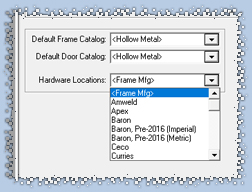|
The ability to accurately position architectural hardware on an opening allows for the creation of several valuable reports. AVAproject provides tools to easily accommodate standard or custom configurations.

When speaking in terms of architectural openings, "hardware locations" refer to the specific placement of individual items such as hinges, locksets and deadbolts. In practice, these locations are determined by the manufacturer of the hollow metal doors and frame that are to receive these products.

|
AVAproject comes preloaded with a complete library of hardware locations for the many popular hollow metal brands. This information is available for viewing right inside the software by clicking on the AVAproject bookshelf icon and selecting the book entitled 'Hardware Locations'.
The 'Hardware Locations' field in the 'Project Info' tab allows users to specify exactly which manufacturer's standard locations will be used throughout the given project. Users may select from any of the manufacturers listed in the AVAproject 'Hardware Locations' library.
|
Alternatively, the special '<Frame Mfg>' option (which is selected by default) indicates that the hardware locations for any given opening are determined by the manufacturer of the frame being used (as defined in the 'Frame Catalog' column in the Openings Schedule). This allows a mixture of manufacturers and location sets to be used within a single project.
| 
|
Despite the comprehensive library of location data contained in AVAproject, there are inevitable situations in which "non-standard" or "custom" location are called for. The most common example of this is the case of retrofit work. When new doors are required to fit existing framed openings, hardware preparations must be located to match.
In AVAproject, custom hardware locations are specified in the 'Vertical Position' column in the Hardware Groups. The nomenclature used in this column is identical to that found in 'Hardware Locations' on the AVAproject bookshelf.
Locations are specified using two letters and a measurement (ie: "TT5" or "BB10"). The first letter establishes a reference point in respect of the opening itself. Vertical positions are mapped from the top, bottom or center of the opening using "T", "B" or "C" respectively. The second letter indicates the reference point on the hardware item itself. Once again, "Top", "Bottom" or "Center". The numbers that follow are the measurement between those to reference points, specified in decimal inches.
As an example, hinges can be located using any of the following:
|
TT5
|
Top of nominal opening to Top of hinge is 5"
|
|
TC7.25
|
Top of nominal opening to Center of hinge is 7 ¼"
|
|
|
|
|
BB10
|
Bottom of nominal opening to Bottom of hinge is 10"
|
|
BC12.25
|
Bottom of nominal opening to Center of hinge is 12 ¼"
|
|
Therefore, to establish positions for a set of three hinges, the string could appear as "TT5,BB10,EQ". Note the use of the term "EQ" at the end of the string; this indicates that the third hinge should be placed at an equal distance between the first two. On an opening that requires four hinges an additional "EQ" can be added, as in "TT5,BB10,EQ,EQ".
| 
|
When AVAproject generates 'Machining Sheets' for openings within a project, location information is adjusted slightly to accommodate the purpose for which they are intended. Machining sheets are designed to facilitate the ordering of custom doors from the manufacturers. By convention, all dimensions are given from the top edge of the door regardless of how they're specified.
Any hardware positioned with respect to the bottom of the opening must be inverted to show its position relative to the top. For example, a 4 ½" hinge located 10" from the bottom of a 7' door, would invert to show a position of 69 ½" from the top.
|
84"(opening height) - (10"(hinge position) + 4 ½"(height of hinge) ) = 69 ½"(from top of opening)
|
Finally, the locations are adjusted once more to being them to the top of the actual door as opposed to the top of the nominal opening. The 'top gap' specified for the opening is subtracted from the 'top of opening' dimension.
|
69 ½"(from top of opening) - ⅛"(top gap) = 69 ⅜"(from top of door)
|

|